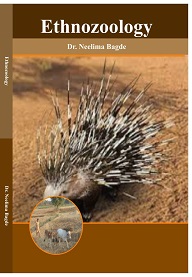Ethnozoology
₹ 400
ISBN Number : 978- 1-73034- 201-1
Book Overview
Ethnobiological knowledge is very ancient in India. Ethnobiology describes how people
of a particular culture and region make use of indigenous plants and animals. Tribal
communities are mainly the forest dwellers who have accumulated a rich knowledge of
forests and forest products over centuries.
Ethno–zoology focuses at direct relationship of animals to mankind. The term ′Ethnozoology′
as a branch of science that deals with role of economically important animals in
life and socio–cultural aspects of tribal or aboriginal peoples. The most important aspect
in this context ramifies on traditional mode of treatments of various kinds of elements
using animals and animal products in tribal community. Although inadequate, attempts
have been made to elucidate medicinal significance of animals and animal products in
certain tribal communities from the Indian subcontinent, Jamir and Lal (2005).
Faunal resources have played a wide range of roles in human life from the earliest days of
recorded history. The variety of interactions between humans and animals is the subject
matter of ethnozoology –the branch of ethnobiology that investigates the knowledge
human societies have accumulated concerning animals, as well as their significance to
those people and their uses. Ethnozoological studies can be a valuable asset to increase
our understanding of the cultural, economic, social, and traditional roles of played by
animals, Alves (2012).
It is estimated that more than 300 million indigenous people live in more than 70
countries in habitats ranging from Artic to the rain forests of Asia. China and India
together have 150 million indigenous tribal people. Over 53 million tribals belonging to
550 tribal communities representing 227 linguistic groups inhabit the Indian
subcontinent. At least 5000 indigenous groups can be distinguished by linguistic and
cultural differences and by geographic separation. These tribal populations depends the
local vegetation for food, shelter and curing most ailments. The wide range of ecotypes or
cultivars of crops existing within these under exploited or less modernized tribal form
offers a solution for the erosion of genetic
diversity also. The tribal communities are spread over varied geographical regions and
climatic zones of the country. Their way of living varies from hunting–gathering, cave
dwelling nomadics to societies with settled cultures. They live in a symbiotic relationship
with the forests and so in harmony with the ecosystem. A central point of all local health
traditions of the tribals and their practitioners is their independent and self–sufficient
nature, Padmnabhan and Sujana (2006).
Ethno–zoology is the study of animals, insects, etc. of a particular culture, usually an
indigenous culture in a non–western society. Ethno–zoology is part of ethnography which
is the study of any particular culture somewhere in the world. Occasionally this
specialization is called zoo–archeology. The archaeological aspects are to us the route to
seeing which birds, bees and other creatures were important to the classic maya, Flaar
(2008).


